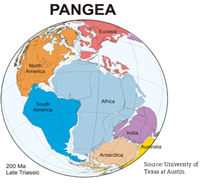Commodity Cycles: Boom, Bust, & Transition Part 1
When I chose Geology as a major, I dove in headfirst not knowing very much about the industry other than a job in this field would allow me to travel and search for gold and copper. I was inspired by my high school teacher who on the first day of class asked us to look at the mural on the wall (the Pangean Supercontinent) and he explained the theory of plate tectonics and why the continents fit together like puzzle pieces. What does this all have to do commodity cycles? Well, while I was in university, I tried to find a summer job in the mining industry and couldn’t find anything – neither could anybody else because the mining industry was out of favour. However, by the time I was about to graduate, the commodity cycle was beginning to ramp up and I was able to capitalize on the change in sentiment by finding work right away, as did twenty of my cohorts. What I learned from the older Prospectors and Geologists during that first year was that mining is either feast or famine. I didn’t quite realize what that phrase meant seeing as I came right out of school and stepped into a gold bull market which lasted 7 to 8 years. It wasn’t until the well started drying up and small junior companies were having trouble raising money and therefore having to slash jobs that I realized how profound that sage wisdom I received in my first year in the industry was. The “old-timers” had seen the cycle repeat itself many times. What I learned during that time onwards has definitely had an influence on our investment process to maximize value during these opportunities.

- Be Prepared & Capitalize: The Resource Fund was created because we were anticipating that sentiment would eventually shift back towards commodities and wanted to be positioned ahead of time for that eventual change in sentiment. We may have been a bit early but better to be early than late.
- Reposition: During the “bust” part of the cycle, steady work was difficult to come by so I took the opportunity to go back to school to get my MBA and look at what other opportunities might be out there. We are constantly searching for the next en vogue commodity to re-position into.
- Transition & Repeat: I completed my MBA and transitioned into the capital markets side of the exploration business in order to use the +10 years of hands on industry knowledge I had gained to help exploit the next cycle.
“This means that” listen to your Elders. I feel my career path has mimicked or maybe even been dictated by the commodity cycles. During my first years in the industry, I never understood how extreme the cycles can be and what my seniors were trying to convey; however, now that I have been through some cycles, we are well prepared to capitalize on it while keeping in mind – what’s next.
National Instrument 31-103 requires registered firms to disclose information that a reasonable investor would expect to know, including any material conflicts with the firm or its representatives. Doug Johnson and/or Pathfinder Asset Management Limited are an insider of companies periodically mentioned in this report. Please visit www.paml.ca for full disclosures.
*All returns are time weighted and net of investment management fees. Returns from the Pathfinder Partners’ Fund and Partners’ Real Return Plus Fund are presented based on the masters series of each fund. The Pathfinder Core: Equity Portfolio and The Pathfinder Core: High Income Portfolio are live accounts. These are actual accounts owned by the Pathfinder Chairman (Equity) and client (High Income) which contain no legacy positions, cash flows or other Pathfinder investment mandates or products. Monthly inception dates for each fund and portfolio are as follows: Pathfinder North American: Equity Portfolio (January 2011), Pathfinder North American: High Income Portfolio (October 2012) Pathfinder Partners’ Fund (April 2011), Pathfinder Real Return Plus Fund (April, 2013), Pathfinder International Fund (November 2014) and Pathfinder Resource Fund (May 2018).
Pathfinder Asset Management Limited (PAML) and its affiliates may collectively beneficially own in excess of 10% of one or more classes of the issued and outstanding equity securities mentioned in this newsletter. This publication is intended only to convey information. It is not to be construed as an investment guide or as an offer or solicitation of an offer to buy or sell any of the securities mentioned in it. The author has taken all usual and reasonable precautions to determine that the information contained in this publication has been obtained from sources believed to be reliable and that the procedures used to summarize and analyze such information are based on approved practices and principles in the investment industry. However, the market forces underlying investment value are subject to sudden and dramatic changes and data availability varies from one moment to the next. Consequently, neither the author nor PAML can make any warranty as to the accuracy or completeness of information, analysis or views contained in this publication or their usefulness or suitability in any particular circumstance. You should not undertake any investment or portfolio assessment or other transaction on the basis of this publication, but should first consult your portfolio manager, who can assess all relevant particulars of any proposed investment or transaction. PAML and the author accept no liability of any kind whatsoever or any damages or losses incurred by you as a result of reliance upon or use of this publication.